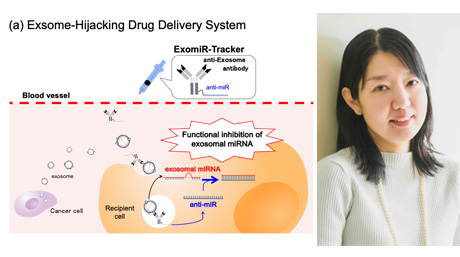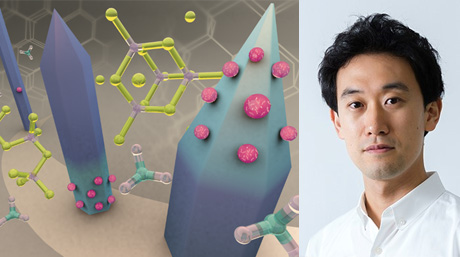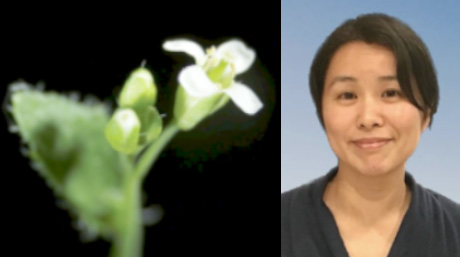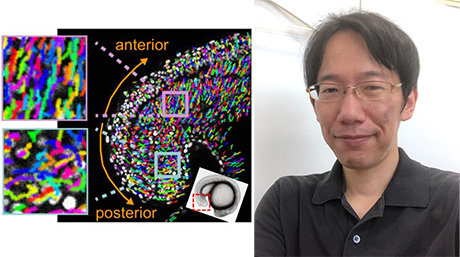Life Science and Technology News
【Labs spotlight】 Ichinose Laboratory
Regulation of the brain by monoamines and biopterin
The Department has a variety of laboratories for Life Science and Technology, in which cutting-edge innovative research is being undertaken not only in basic science and engineering but also in the areas of medicine, pharmacy, agriculture, and multidisciplinary sciences.
This "Spotlight" series features a laboratory from the Department and introduces you to the laboratory's research projects and outcomes. This time we focus on Ichinose Laboratory.

Areas of Supervision
Primary/Life Science and Technology
Secondary/Science and Technology for health Care and Medicine, Human Centered Science and Biomedical Engineering
Professor Hiroshi Ichinose![]()
| Degree | PhD 1989, Nagoya University; 1990, Tokyo Institute of Technology |
|---|---|
| Areas of Research | Biochemistry, Neurochemistry |
| Keywords | Dopamine, Serotonin, Tetrahydrobiopterin, Neuro-psychiatric disorders |
| Website | Ichinose Laboratory (Japanese) |
Research interest
1. Understanding the molecular mechanisms of brain differentiation and development
When neurons differentiate during a developmental phase, how does the brain know which neurotransmitters to be synthesized?
An infant’s environment is said to have an effect on the development of its brain. So, what does ‘brain development’ actually mean in scientific terms?
2. Relationship between the function of monoamine neurons and the clinical condition
People’s personalities differ. What are the differences inside our brains that cause these differences in personality? Monoamines are important neurotransmitters in the brain which are closely linked to emotion.
How is the biosynthesis of monoamines in the brain regulated? And how does this process effect a person’s personality and temperament?
Change in activity of monoamine neurons in the brain would be related to the pathology of neuropsychiatric disorders such as Parkinson’s disease and bipolar disorder. Tetrahydrobiopterin is a cofactor of monoamine biosynthetic enzymes. How is tetrahydrobiopterin metabolized in the body and how is it related to the regulation of the amount of monoamine produced in the brain?
In order to tackle the research topics listed above, we are focusing on methodologies in biochemistry and molecular biology to conduct analysis from the molecular level through to the cell and organism level using cultured cells and transgenic mice.
We are utilizing genetically modified animal models to analyze how the animal’s behavior changes when the level of amines in the brain is artificially altered and whether such animals can be used to model the clinical condition of Parkinson’s disease and other disorders. We are hoping our results can be used to discover the pathogenic mechanisms of disease and develop new treatment and prevention therapies.
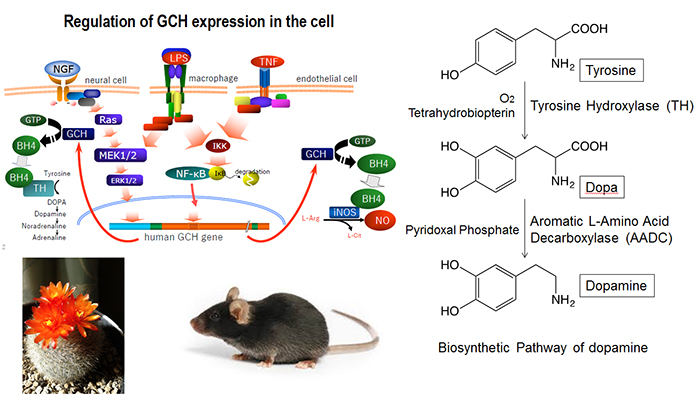
Research findings
Selected publications
- [1] Ishikawa T, Imamura K, Kondo T, Koshiba Y, Hara S, Ichinose H, Furujo M, Kinoshita M, Sawada H, Takahashi J, Takahashi R, Inoue H. Genetic and pharmacological correction of aberrant dopamine synthesis using patient iPSCs with BH4 metabolism disorders. Hum Mol Genet, (in press)
- [2] Kawahata I, Ohtaku S, Tomioka Y, Ichinose H, Yamakuni T. (2015) Dopamine or biopterin deficiency potentiates phosphorylation at Ser and ubiquitination of tyrosine hydroxylase to be degraded by the ubiquitin proteasome system. Biochem Biophys Res Commun 465: 53-58.
- [3] Xu F, Sudo Y, Sanechika S, Yamashita J, Shimaguchi S, Honda SI, Sumi-Ichinose C, Mori-Kojima M, Nakata R, Furuta T, Sakurai M, Sugimoto M, Soga T, Kondo K, Ichinose H (2014) Disturbed biopterin and folate metabolism in the Qdpr-deficient mouse. FEBS Lett 588: 3924-3931
- [4] Liang Y, Inagaki H, Hao Q, Sakamoto M, Ohye T, Suzuki T, Ichinose H (2013) Identification of an enhancer region for immune activation in the human GTP cyclohydrolase I gene. Biochem Biophys Res Commun 442: 72-78
- [5] Homma D, Katoh S, Tokuoka H, Ichinose H (2013) The role of tetrahydrobiopterin and catecholamines in the developmental regulation of tyrosine hydroxylase level in the brain. J Neurochem 126: 70-81
- [6] Toda T, Homma D, Tokuoka H, Hayakawa I, Sugimoto Y, Ichinose H, Kawasaki H (2013) Birth regulates the initiation of sensory map formation through serotonin signaling. Dev Cell 27: 32-46
- [7] Tokuoka H, Muramatsu S, Sumi-Ichinose C, Sakane H, Kojima M, Aso Y, Nomura T, Metzger D, Ichinose H (2011) Compensatory regulation of dopamine after ablation of the tyrosine hydroxylase gene in the nigrostriatal projection. J Biol Chem 286: 43549-43558
- [8] Koshiba S, Tokuoka H, Yokoyama T, Horiuchi E, Ichinose H, Hasegawa K (2011) Biopterin levels in the cerebrospinal fluid of patients with PARK8 (I2020T). J Neural Transm 118: 899-903
- [9] Homma D, Sumi-Ichinose C, Tokuoka H, Ikemoto K, Nomura T, Kondo K, Katoh S, Ichinose H (2011) Partial biopterin deficiency disturbs postnatal development of the dopaminergic system in the brain. J Biol Chem 286: 1445-1452
- [10] Kadkhodaei B, Ito T, Joodmardi E, Mattsson B, Rouillard C, Carta M, Muramatsu S, Sumi-Ichinose C, Nomura T, Metzger D, Chambon P, Lindqvist E, Larsson NG, Olson L, Bjorklund A, Ichinose H, Perlmann T (2009) Nurr1 is required for maintenance of maturing and adult midbrain dopamine neurons. J Neurosci 29: 15923-15932
- [11] Sato K, Sumi-Ichinose C, Kaji R, Ikemoto K, Nomura T, Nagatsu I, Ichinose H, Ito M, Sako W, Nagahiro S, Graybiel AM, Goto S (2008) Differential involvement of striosome and matrix dopamine systems in a transgenic model of dopa-responsive dystonia. Proc Natl Acad Sci USA 105: 12551-12556
- [12] Suzuki T, Yamakuni T, Hagiwara M, Ichinose H (2002) Identification of ATF-2 as a transcriptional regulator for the tyrosine hydroxylase gene. J Biol Chem 277: 40768-40774
- [13] Sumi-Ichinose C, Urano F, Kuroda R, Ohye T, Kojima M, Tazawa M, Shiraishi H, Hagino Y, Nagatsu T, Nomura T, Ichinose H (2001) Catecholamines and serotonin are differently regulated by tetrahydrobiopterin: a study from 6-pyruvoyltetrahydropterin synthase knockout mice. J Biol Chem 276: 41150-41160
Contact
Professor Hiroshi Ichinose
Room 820, B2 building, Suzukakedai campus
E-mail : hichinos@bio.titech.ac.jp
*Find more about the lab and the latest activities at the lab site (Japanese)![]() .
.
*May 1, 2025:Some of the content has been updated with the latest information.

